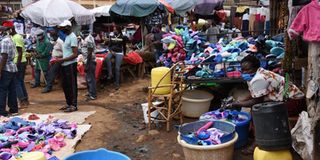Kenyans defy virus rules, go back to normal

Business goes on at a Kawangware market in Nairobi on April 30, 2020 despite rising coronavirus cases. PHOTO | FILE | NATION MEDIA GROUP
What you need to know:
- People had gained some false sense of security from the observation that although the number of positive cases is rising, only a few are dying.
- That most Kenyans live from hand to mouth also makes it impossible to lock them in for long, especially in the informal settlements.
Kenyans are gradually resuming their normal lives after nearly three months of disruption occasioned by the Covid-19 crisis.
Unlike the first weeks of the containment measures when fear ruled and the streets of Nairobi emptied as many organisations assumed a work-from-home formula, traffic is back.
Many are now going out to eke out a living as the economy continues to crumble.
From the ghost town that it was, the markets and stalls are now open and full with clients who show no inkling of fear for the coronavirus that broke out in China in the last quarter of 2019.
There is no exception, even among those identified by medics as the most vulnerable to the disease, including elderly citizens and those with pre-existing medical conditions.
Ms Elizabeth Obonyo, a 62-year-old fish monger in Kawangware, one of the hotspots, is among those who have made peace with the threat and returned to their trade with their hopes placed in God, sanitisers and masks.
“I have had to leave my cubicle and continue with my business so I can get rent and meet other pressing needs. The government may want us indoors, but it does not provide us with basic necessities,” said the mother of four. “So as we keep the disease at bay with masks and by washing our hands, we also have to stop our children from dying of hunger.”
SENSE OF SECURITY
Tough economic times, distrust of the government’s daily statistics of the disease and few deaths recorded out of the positive cases are some of the reasons people have resorted to defying government directives to stay at home, while others fail to wear masks or observe social distancing.
This is despite some experts warning that the normalcy has come too soon, considering that the worst is yet to come. The Ministry of Health projected that the number of positive cases would peak in July and August.
But the doubtful residents of Mathare, where 14 people were diagnosed with the disease as of Thursday, say they do not know a single person from the area who is in the government records as having turned positive.
“The government says there are cases here, but we haven’t heard of any at all. As a community, we would have known at least of a case,” said Ms Agnes Waithera, who resides in Mlango Kubwa.
Dr Mary Nyamongo, a social scientist, told the Saturday Nation that the people had gained some false sense of security from the observation that although the number of positive cases is rising, only a few are dying.
“We are dangerously beginning to normalise the disease and taking preventive measures for granted. People are wearing masks only to avoid arrests. These behaviours show that people have begun to doubt the seriousness of the condition,” she said.
POVERTY
“Initial projections indicated that by April, the number of positive cases would have clocked 10,000. But only 700 cases were recorded. This, and the fact that there have been fewer deaths than had been feared, are giving people a false sense of security that they are not as vulnerable after all,” she explained.
That most Kenyans live from hand to mouth also makes it impossible to lock them in for long, especially in the informal settlements ravaged by hunger and inability to meet everyday needs.
Dr Nyamongo, who also champions the rights of Kenyans living with non-communicable diseases, said the vulnerable lot has also been forced to venture out “too soon” since they have not been provided with relief.
President Uhuru Kenyatta, in his address last week, hinted at the possibility of lifting curfew and lockdown rules.





